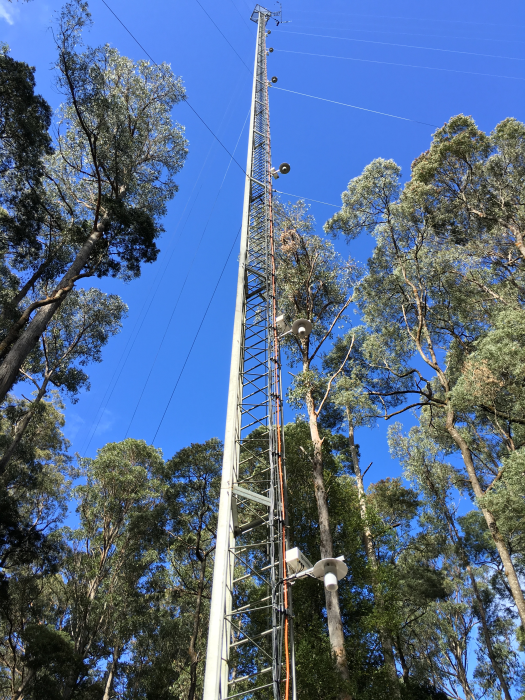





タスマニア州南西部にあるワラ長期生態学研究 (LTER) サイトは、湿潤ユーカリ林内の長期的な生態学的健全性と動態を監視するために 1995 年に設立されました。サイト面積は 15,900 ヘクタール (61.4 平方マイル) で、一部はタスマニア荒野世界遺産地域 (保護のために管理) に含まれ、一部は州有林 (木材生産を含む多目的に管理) に含まれています。サイトでの研究の主な研究目的は次の通りです。
- 過去の自然火災に起因する、混合年齢の高く湿ったユーカリの森における炭素蓄積と分解の生態生理学的プロセスと速度を研究する。
- 渦共分散微気象学的手法を用いて森林と大気の間の二酸化炭素、水蒸気、エネルギーの交換を測定する
- 生態生理学的プロセスと炭素蓄積および分解速度をサイトの生物相と関連付ける
- フラックスタワーの測定をリモートセンシングデータおよび地表モデルと組み合わせて使用し、地域規模での炭素と水の純交換を拡大および推定する。
Warra LTER サイトには、OzFlux ネットワーク ( www.ozflux.org.au ) および Australian Supersites ネットワークの一部であるフラックス タワーがあります。フラックス タワーは、80 メートル (262 フィート) の支柱付きスチール ラティス タワーで構成されています。熱、水蒸気、二酸化炭素の乱流フラックスは、渦サンプル吸気口を備えた Campbell Scientific CPEC200 クローズド パス エディ コバランシング システムを使用してタワーの上部で測定されます。8 つの吸気口を備えた Campbell Scientific AP200 プロファイル システムと一連のApogee 吸引温度センサーの組み合わせにより、水蒸気、二酸化炭素、温度の垂直プロファイルが得られます。
プロファイルは、2 つのガスと熱の貯蔵量の変化 (つまり、蓄積または減少) を計算するために使用されます。貯蔵量の変化は乱流フラックスに追加され、各スカラーの総フラックスまたは純生態系交換を決定します。プロファイル システムは、乱流強度が低いとき (夜間など) や特に大きな森林樹冠内で貯蔵量の変化が顕著になる Warra のような場所で特に役立ちます。
樹冠上では、キャンベル サイエンティフィックの機器を使用して、温度と湿度、風速と風向、降雨量、入射短波放射と反射短波放射、純放射などの補足測定も行われます。地上レベルでは、時間領域反射率測定 (TDR) 機器を使用して土壌水分含有量が測定され、土壌熱流束と土壌温度も測定されます。
ワラ LTER サイトが設立されて以来、200 件を超える研究プロジェクトがこのサイトで実施され、そのうち 10 件のプロジェクトはアイコン プロジェクトに指定されており、長期 (15 年以上) にわたって再測定を継続するという明確な意図を持って設計されています。ワラ フラックス タワーは、この 10 件のアイコン プロジェクトの 1 つです。
注: TERN Australia はこのプロジェクトに関するビデオを Vimeo に投稿しています: https://vimeo.com/260745357。
ケーススタディの概要
アプリケーション
湿潤ユーカリ林における長期生態学的研究場所
ワラ LTER サイト、タスマニア、オーストラリア使用製品
CR3000 CPEC200 CR1000 AP200寄稿者
Campbell Scientific AustraliaTim Wardlaw, Forestry Tasmania
参加団体
タスマニア林業計測項目
貯蔵量の変化を計算するためのCO2 密度、 H2O 密度、温度の垂直プロファイル、渦流を計算するために使用される CO2密度、, H2O 密度、 音速、3D 風の高周波測定、気温、湿度、風速と風向、降雨量、入射および出射短波放射、正味放射、フェノロジー、土壌水分含有量、土壌熱流束、土壌温度関連ウェブサイト
Warra Tall Eucalypt SuperSiteOzFlux Land-Atmosphere Observatory
Warra Long-Term Ecological Research
PDFで見る